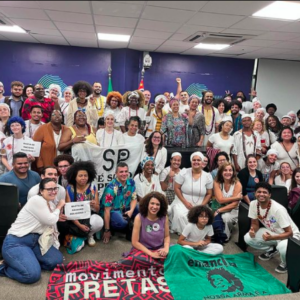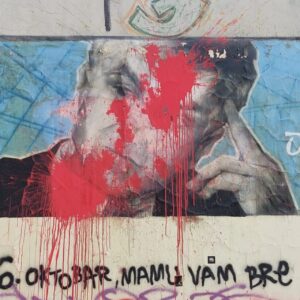

Contested Murals in Belgrade, Partizan[1], ”Grobarski Trash Romanticism” and the ”JNA group”
By Hana Šuica •
Attitudes towards national history in Serbia represent an important aspect of everyone’s identity. It is understandable that historical and political figures stand out among the multitude of painted murals. They are increasingly present in public spaces, both on the facades of residential buildings and on public surfaces, such as communal areas or the walls of abandoned industrial structures. This phenomenon is not unique to Serbia, as the representation of famous (historical) figures from art, science, politics, and sports is widespread. Portraits belonging to this group of murals are universally recognisable or at least recognisable at the national or local level if they are part of the history of a particular place. However, murals found in Belgrade possess a unique ability to evoke strong emotions and spark controversy, contingent upon the context in which they are situated. While some murals serve as poignant commemorations, honouring significant events and figures, others can be polarising due to their portrayal of contentious narratives.
In Belgrade, there is one specific group of murals, with only black and white colours, most often painted in the centre of the city, starting from the Dorćol area and spreading to other Belgrade municipalities and neighbourhoods, mainly in the districts of Vračar, Stari Grad, and Savski Venac. These murals bear the characteristics of the Grobarski Trash Romanism (GTR) and the punk band Grupa JNA (JNA group), oriented towards supporting the sports club Partizan. ‘Grobari’ is the name of Partizan fans. These portraits were initiated by the GTR and JNA group in 2015 and consist of black-and-white murals depicting public figures from Serbia and around the world (actors, athletes, musicians). Persons portrayed often wear a Partizan jersey and feature a quote from the depicted person. The idea behind these murals is to associate cheering (for a sports club) with the values of civic society and the element of pathos authors represent. People in Serbia usually see young men cheering for a football club as hooligans and relate them to violence and destructive behaviour during football games. The collective is trying to challenge that narrative.
In contrast to the depiction of a tough-looking hooded hooligan, where the emphasis is on projecting a sense of masculinity, a significant shift occurs here. This shift is centred around the civic values the subjects embody in these portrayals, moving away from the collective and anti-social themes. However, it is important to note that within the visual language of fans, there are still connections to nationalism, traditionalism, and violence. Through a meticulous selection of individuals who presently serve as distinctive symbols of urban and civic culture, the intention is to engage diverse social groups and individuals. These chosen figures resonate with various communities that might find the previously mentioned fanatical and aggressive hooligan unappealing for multiple reasons. Beyond mere formal considerations, this deliberate selection reflects a different target audience for these portrait messages.
Murals illustrating notable historical figures from Serbian history are pretty common in Belgrade, and a few figures are found more frequently than others. One of those figures is Gavrilo Princip, portrayed in several locations throughout the city. Princip is the Bosnian Serb student who assassinated Archduke Franz Ferdinand on June 28, 1914. His image has a political and ideological context, symbolising national pride, revolutionary spirit, the struggle for liberation, and Serbian unity. Alongside the portrait of Princip, one can often find the quote, ‘Our shadows will walk through Vienna, roam the palace, and frighten the gentlemen.’ The quote is believed to stem from Princip’s time in prison in Sarajevo and later Terezín (Theresienstadt- the same town later known for the notorious Nazi concentration camp), where he died in April 1918.
The breakup of Yugoslavia and the wars that followed it have been devastating for Serbia and the neighbouring countries. As a result of harmful politics during and after the wars, certain personalities are celebrated as war heroes even though their actions encompassed heinous atrocities and resulted in convictions. A mural featuring Ratko Mladić, leader of the Army of Republika Srpska in the 1990s, is located at the corner of Njegoševa and Alekse Nenadovića Street in Belgrade. This mural depicts Mladić in a military uniform, saluting with a distant gaze away from the viewer and alongside him are the words ‘General, we thank your mother.’ [2] This mural appeared in July 2021, about one month after rejecting Mladić’s appeal against his war crimes convictions in 2017. The author – or authors – of the mural remains unknown. Residents of the building on which it appeared tried but failed to get municipal utility companies to erase it. [3] Since its creation, the mural has gained significant media attention and sparked protests from civic activists. Each time the mural was damaged, a group of anonymous young men repaired it within 24 hours, sometimes even within a few hours on the same day. Civil activists threw eggs at the mural of Mladić on November 13, 2021. Serbian police banned activists from the Youth Initiative for Human Rights, a Belgrade-based NGO, from holding a public gathering to paint over the mural. [4] The protest that ensued was not the first one, but it was the first time opponents of the mural had publicly voiced their opposition. In contrast, prior interventions around the mural had been anonymous. After this incident, stencils featuring Ratko Mladić’s image and the message ‘Ratko Mladić, war hero’ appeared all over Belgrade. It is important to note that this is not the only mural of Ratko Mladić in Belgrade but is the most controversial one.
After the recent school shooting on May 3, 2023, in Belgrade, Mladić’s mural was painted over with white paint with the Partizan supporters’ message ‘Turn on your brain, turn off Pink’ with the TV Pink logo crossed out. TV Pink is one of the biggest supporters of the current regime. This television is known for cultivating offensive rhetoric, giving the platform to mobsters, war criminals and bullies. Additionally, they have been linked to the rise of violence many believe resulted in the school shooting. The mural included the insignia of a Partizan supporter group believed to have ties with the authorities. [5]
The mural is flanked on one side by a similar mural of the leader of the Chetnik Detachments of the Yugoslav Army, Dragoljub ‘Draža’ Mihailović, who was convicted of war crimes after WWII, and on the other side with a mural of WWI Serbian Army Field Marshal Živojin Mišić. All three murals include the coat of arms of the Partizan fan club. [6] Draža Mihailović murals are common in Belgrade but have rarely sparked controversies. However, after the school shooting in Belgrade, many were partly demolished and painted over with red paint.
Belgrade has become a collection of symbols representing the struggle and confrontation of ideologies between two groups of people, anonymous and quarrelling through the city’s facades. If the city is perceived as a discourse, the ‘vocabulary’ of individuals is often not shaped spontaneously but is significantly influenced by the identity politics of different social groups. The urban space is often perceived as a stage for inscribing representations of the past and public manifestations of collective memories. Mechanisms of power almost always condition collective memory in contemporary societies, and unlike individual memory, it is usually regulated and ideologically formed. This phenomenon, which is part of our everyday life, echoes the conclusion of sociologist Todor Kuljić that ‘contemporary memory culture is bureaucratically and commercially organised and politically instrumentalised history. Coherent pasts are invented, decreed, and used for entertainment.’
The content of the official or dominant ideologies promoted in a society largely depends on the top of the social and political elite and how actors in lower positions implement them. The construction of the urban text depends on the ruling ideologies in a particular society but is carried out by various social actors with diverse capacities of power and influence. These specific actors, in cases of memorialisation of public space, can be referred to as ‘memorial entrepreneurs’ – individuals engaged in specific transformative actions aimed at achieving a certain result, which, in the case of implementing a memorial agenda, would be the creation of memorial sites in public space.
For more on street art in Belgrade, see this post on the Beotura website.
All photographs are from the author.
About the Author:
Hana Šuica recently completed her master’s degree in the Faculty of Media and Communication at Singidunum University in Belgrade. Her master’s thesis dealt with murals as a form of funerary art and a symbol of contemporary commemorative culture. She is currently working on a personal project for which she is collecting and cataloguing murals across Belgrade and Serbia, researching the stories behind funerary portraits. She hopes to start working as a PhD researcher to continue her study of funerary murals.
End Notes:
[1] Partizan Football Club is a Serbian professional football club based in Belgrade. It forms a major part of the Partizan multi-sport club.
[2] Nevena Bogdanovic, Predrag Urosevic, Andy Heil, “Graffiti War: Battle In The Streets Over Ratko Mladic Mural”, Radio Free Europe Radio Liberty, November 10, 2021. https://www.rferl.org/a/serbia-mladic-mural-protests/31555357.html.
[3] Milica Stojanovic, “Serbian Activist Tried for Defacing Ratko Mladic Mural”, Balkan Insight, March 22, 2022. https://balkaninsight.com/2022/03/22/serbian-activist-tried-for-defacing-ratko-mladic-mural.
[4] Milica Stojanovic, “Serbian Activist Tried for Defacing Ratko Mladic Mural”, Balkan Insight, March 22, 2022. https://balkaninsight.com/2022/03/22/serbian-activist-tried-for-defacing-ratko-mladic-mural.
[5] N1 Belgrade, “Anti-Pink TV message painted over Mladic mural”, N1, May 12, 2023. https://n1info.rs/english/news/anti-pink-tv-message-painted-over-mladic-mural/.
[6] N1 Belgrade, “Anti-Pink TV message painted over Mladic mural”, N1, May 12, 2023. https://n1info.rs/english/news/anti-pink-tv-message-painted-over-mladic-mural/.
[7] Tudor Kuljić, Kultura sećanja: Teorijska objašnjenja upotrebe prošlosti (Belgrade: Čigoja, 2006).



